浙江新高考概要写作
浙江新高考英语题型解读—概要写作

浙江新高考英语题型解读—概要写作一、浙江新高考《考试说明》英语写作样题阅读下面短文,根据其内容写一篇60词左右的内容概要。
Getting rid of dirt, in the opinion of most people, is a good thing. However, there is nothing fixed about attitudes to dirt.In the early 16th century, people thought that dirt on the skin was a means to block out disease, as medical opinion had it that washing off dirt with hot water could open up the skin and let ills in. A particular danger was though to lie in public baths. By 1538, the French king had closed the bath houses in his kingdom. So did the king of England in 1546. Thus began a long time when the rich and the poor in Europe lived with dirt in a friendly way. Henry IV, King of France, was famously dirty. Upon learning that a nobleman had taken a bath, the king ordered that, to avoid the attack of disease, the nobleman should not go out.Though the belief in the merit (好处) of dirt was long-lived, dirt has no longer been regarded as a nice neighbor ever since the 18 century. Scientifically speaking, cleaning away dirt is good to health. Clean water supply and hand washing are practical means of preventing disease. Yet, it seems that standards of cleanliness have moved beyond science since World War II. Advertisements repeatedly sell the idea: clothes need to be whiter than white, cloths ever softer, surfaces to shine. Has the hate for dirt, however, gone too far?Attitudes to dirt still differ hugely nowadays. Many first-time parents nervously try to warn their children off touching dirt, which might be responsible for the spread of disease. On the contrary, Mary Ruebush, an American immunologist (免疫学家), encourages children to play in the dirt to build up a strong immune system. And the latter (后者) position is gaining some ground.One possible version:People have mixed opinions towards dirt on our skin. (要点 1 ) For a long time in history, people of some European countries, such as France, believed that dirt protected people from getting ill. (要点 2 ) However, people began to change their attitudes to dirt about 200 years ago. People have been told that washing dirt off our body can keep us healthy. (要点 3) However, some scientists believe that exposure to some dirt may help our immune system. (要点 4)1. 文章第一段就是本篇文章的主题句,亮明了总的观点:However, there is nothing fixed about attitudes to dirt. 换句话说:Different people have different attitudes towards dirt. 再结合下文谈到的主题可知Different people have different attitudes towards dirt on the skin. 范文中的要点1“People have mixed opinions towards dirt on our skin.”概括非常精炼。
浙江新高考之概要写作summarywriting
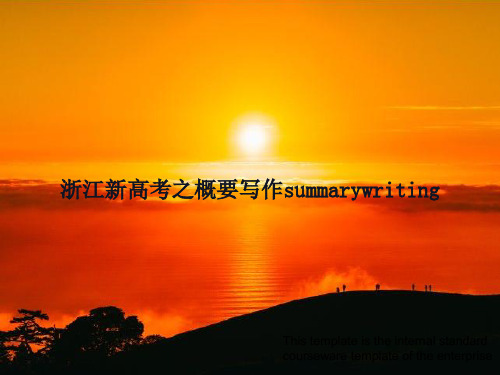
7.基本句型间灵活转换
Dirt on the skin was a means to block out disease.
S+V+P
S+V+O
Dirt on the skin could protect people from getting ill.
8. 特殊句式(强调句,倒装句,there be) 和正常语序句式的转化 To research whether such a “sixth sense” really exists, Robert Baker, …
keep…free from
✓In the early 16th century, people, especially those
in some European countries, thought that dirt on
the skin could protect them from getting ill.
2. 消减事例 (尽量减少实事,大胆省略实事)
3. 省略细节
essential information
In the early 16th century, people thought that dirt on the skin was a means to block out disease, as medical opinion had it that washing off dirt with hot water could open up the skin and let ills in. A particular danger was thought to lie in public baths. By 1538, the French king had closed the bath houses in his kingdom. So did the king of English in 1546.
浙江省英语高考概要写作首考试题分析及反思

浙江省英语高考概要写作首考试题分析及反思近年来,英语高考概要写作成为了浙江省英语高考的一项重要考查内容。
概要写作是要求考生根据所给文章的具体内容和要求,进行提纲挈领式的概括和归纳。
通过这项考查,能够测试考生对于文章主旨大意和关键信息的把握能力,同时也能考察考生的语言表达和组织能力。
今年的概要写作首考试题如下:假定你是李华,你的高中同学小雨因病缺课长达一个多月。
某天在上学路上,你意外地遇到他。
了解到他的病情已好转,并受到班级同学的帮助和鼓励,你深为感动。
请根据以下要点给他写一封信:1. 向他询问病情和学习情况。
2. 对班级同学的帮助和鼓励表示感谢。
3. 鼓励他继续努力学习。
题目要求考生根据所给的要点进行提纲挈领式的概述,总结出一封符合要求的信件的结构和内容。
对于此类概要写作,考生首先需要仔细阅读所给文章和要点,确保完全理解文章的主旨大意和关键信息。
接下来,考生要根据文章的内容和要求,进行信息的筛选和排序,以确保提纲的准确和逻辑性。
在提纲的过程中,考生应注意概述的全面性和合理性,避免遗漏重要信息和破坏文章的逻辑关系。
通过对今年考题的分析,可以得出以下几个结论和反思:考生在答题前要仔细审题,全面理解文章的内容和要求。
本题要求考生写一封给因病缺课长达一个多月的小雨的信,询问他的病情和学习情况,对班级同学的帮助和鼓励表示感谢,并鼓励他继续努力学习。
考生在审题时应注意理解题目所给的情境和人物关系,避免写错信的对象或在信中包含与题目要求不符的内容。
考生在概述提纲时要确保信息的全面和准确。
本题要求考生询问小雨的病情和学习情况,对班级同学的帮助和鼓励表示感谢,并鼓励他继续努力学习。
考生应在提纲中包括这些要点,并根据信息的重要性和逻辑关系进行排序和组织。
在本题中,可以先询问小雨的病情和学习情况,然后表达对班级同学的感谢,并最后鼓励小雨继续努力学习。
考生在组织语言时要清晰、准确地表达。
英语概要写作要求考生使用简练、准确的语言进行表达,注意语法和拼写的正确性。
浙江省高考新题型概要写作训练指导

纲要写作[考纲解读 ]供给一篇 350 词之内的短文,要求考生鉴于该短文写出一篇 60 词左右的内容纲要。
[原题剖析 ]1.原文资料 350 词之内,纲要写作 40~80 词。
2.原文以说明文、谈论文为主。
3.纲要,基本就是段落粗心。
每段用一句话归纳,或许两段一个粗心,最多用两句话归纳。
4.要侧重训练自己文章要旨粗心和各段段落粗心的归纳归纳能力。
[写作注意事项 ]1.找重点词和主题句,正确理解、剖析原文重点,归纳段落粗心。
2.各重点的表达要相对独立。
3.各重点之间要有适合的连接。
4.句型力争简单,每句话要表意理解,无空泛、抽象、含混之词。
5.尽量使用短句,慎用长难句。
比如,尽量少用关系代词 which,who 等指引的定语从句,而采纳-ing 形式和-ed形式作定语。
6.多使用归纳性词语,少用详细描绘性词语。
[纲要模板及句型 ]1.表示文章的内容以及研究目的①This paper is aimed at/covers/mainly deals with...②The article focuses on the topic of...2.表示研究的结论①The result showed that...②The author found that...③It was concluded that...3.表示介绍、看法或建议The author suggests/considers that...Suggestions are made for...实战操练 1阅读下边短文,依据其内容写一篇 60 词左右的内容纲要。
As most children return to school, many affluent families are choosing to pull their children out of themainstream education system altogether in favor of having a tutor at home "Around 50 percent of theinquiries we're getting at the moment are for long-term, daily home tutoring," Steve Spriggs, managingdirector of London-based private tutoring service And, he adds, the trend has grown from families asking forpersonal tutors to replicate the classroom environment in their own homes. Many families that were makingthe inquiries for full-time home tutors, Spriggs said, were either travelling so frequently that sending theirchildren to one school was impractical and others did not want their children to go into boarding school.Home tutoring is nothing new, and many tuition firms also offer extra tutoring services to familieswanting their children to have a little extra help learning aheadof entrance exams at competitive privateschools in the U.K., such as Harrow, St. Pauls or Eton."We always make it clear to parents that we will only offer full-time home schooling for a yearthough," Spriggs explained. "Any more than a year and children start to lose out on what a schoolenvironment can give them, such as social skills and that vital interaction they need –although we try tomitigate that anyway in our home tutoring with sports clubs of museum trips as part of the teachingprogram."Spriggs said that the costs of hiring a full-time tutor would exceed the fees of a top boarding school,which usually charge around 35,00£0 ($54,400) a year. Some families employ two full-time tutors, one tocover humanities and the other to cover science and maths. Devising an educational plan for youngsters inthese situations is not a quick process, however, taking up to six weeks to plan, Spriggs said,with a tutorbeing matched to the child to ensure they are compatible.参照范文: Home tutoring isn ’trare in society. Some rich families choose full-time tutors because of frequenttravelling or because they don ’t want their children to go into boarding sch要oo点l.( 1) Meanwhile, to perform betterin entrance exams, some children need extra tutoring services.( 重点 2) Some tuition firms add some activities to improve the social skills of the children .( 重点 3) Although the costs of home tutoring are high, some families still employ two full-time tutors to ensure their children can gain balanced development.( 重点 4)实战操练 2阅读下边短文,依据其内容写一篇 60 词左右的内容纲要。
浙江新高考概要写作
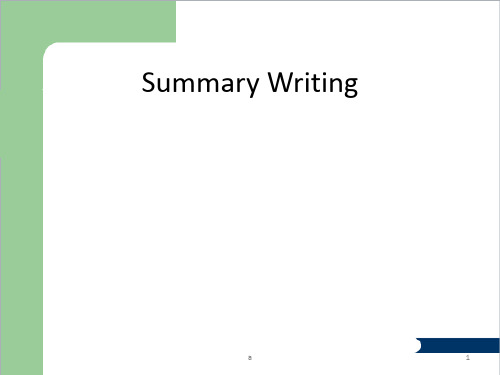
a
1
ห้องสมุดไป่ตู้
Lead-in
Classic rules for ___________: 1. Bad news sells. 2. If it bleeds, it leads. 3. No news is good news, and good news is no
news.
• Tshceiennetwistfsinhdaivnegfiosutnhdatt_h_a_t_g_o_osdprneeawdsfacsatner and
fasrptrheeardinfa_s_t_e_r_a_n.d farther than disasters and
• (Wsohbilsetomraiesss. media usually tend to share
But now that information is being spread
and monitored (监控) in different ways,
researchers are discovering new rules. By
tracking people's e-mails and online posts,
• TopYiocusednotne'nt cweainst..t.h. em to think of you as a • UnDlikeebbmieasDsomwendeira.,"you tend to share _______( )
you don't want to be a/an________ friend.
a
4
Paragraph 1
• Bad news sells. If it bleeds, it leads. No news is good news, and good news is no news. Those are the classic rules for the evening broadcasts and the morning papers. But now that information is being spread and monitored (监控) in different ways, researchers are discovering new rules. By tracking people's e-mails and online posts, •sciTeonptiisct?sThoapviec sfoeunntedntchea?t good news can •sprIesatdhefafsitresrt asnedntfeanrtcheerththeatnopdiiscasters and sobsesntoterinesc.e?
浙江高考英语写作概要写作

最新浙江高考英语写作概要写作1.题型介绍◆选材特点(1)所需阅读的短文词数在350以内;(2)所选材料体裁没有限制,以说明文、议论文和记叙文为主。
◆评分参考(1)对原文要点的理解和呈现情况;(2)应用语法结构和词汇的准确性;【(3)上下文的连贯性;(4)对各要点表达的独立性情况。
注意:理解准确,涵盖全部要求,完全使用自己的语言,准确使用相应的语法结构和词汇,得分相应比较高。
相反,如果概要写作部分出现两句以上整句抄自原文现象,得分档次将会大大降低;所写内容与所提供内容无关不得分。
2.考查能力概要写作是阅读理解和书面表达二者的有机结合体。
简言之就是简要概括所给文章中心大意。
要求读者把文章的具体信息用具有概括功能的词和句表述出来,而非抄袭文章原句,更不是把细节性信息作为中心,而是要通过对文章中的单词、词组和句子进行合理转换,对文章的具体信息进行概括,再用合适的语言表述出来。
这一题型主要考查学生对文章主旨大意的概括和准确获取关键词的能力,同时考查学生用简洁的语言概括文章重要信息的能力以及对文章整体结构的把握能力。
3.写作步骤(1)通读全文。
明确文章类型,主题,结构。
记叙文:5W+1H&议论文:观点、论点、论据说明文:说明对象,说明方式(2)要点获取(4-5点)。
寻找主题句;关键词;提问题。
(3)要点转述。
同义替换;语态转换;词性改变;句子重构(4)要点衔接。
过渡型词句,逻辑连接词。
Writing 1阅读下面短文,根据其内容写一篇60词左右的内容概要。
Yesterday Matt was sick.I picked up Archie from the sitter and Eloise from school and decided to run to Target for a few things.I had hoped to be in and out quickly.~I found a line with just one person ahead of me and began organizing my items on the conveyor.After placing my items,I looked up to see that the person ahead of me was an elderly woman. She was paying for her items with change and wanted to purchase each separately.I was frustrated with this woman and the inconvenience she had placed on me.But then I watched the young employee with this woman.I watched him help her count her change,ever so softly taking it from her shaking hands. When she asked if she had enough to buy a reusable bag,he told her she did and went two lines over to get one for her and then repackaged her items.Never once was this employee angry.He was nothing but patient and kind.As I was watching him,I saw that Eloise was too.She was standing next to the woman,watching the employee count the change.I realized I hadn’t been inconvenienced at all.That my daughter was instead witnessing kindness and patience and being taught this valuable lesson by a complete stranger.When the woman was finished,the employee began ringing up my items and thanked me for my patience.I then thanked him for teaching us patience andkindness by his treatment of that elderly woman.When he was finished I pushed my cart through the store trying to find the manager.I wanted her to know of the employee’s kindness and patience and how much it meant to me.After tracking her down and sharing the story with her,we left Target with a cart full of consumable items,but what is more,a heart full of gratitude for such an invaluable lesson.If you are ever in the Glendale Target,give Ishmael a smile and a nod.The world could use more people like him.________________________________________________________________________________________________________________________________________________________________________________________________…【写作指导】要写好记叙文的概要,先要找到以下两个问题的答案:(1)谁做了什么?(2)结果如何?如果是夹叙夹议文,还要加上这个故事给人们的启示或教育意义。
浙江高考英语概要写作真题汇总及评分标准(附参考范文)

1.概要写作真题阅读下面短文,根据其内容写一篇60词左右的内容概要。
(2019年6月浙江卷) Parents everywhere praise their kids. Jenn Berman, author of The A to Z Guide to Raising Happy and Confident Kids, says, “We’ve gone to the opposite extreme of a few decades ago when parents tended to b e more strict.” By giving kids a lot of praise, parents think they’re building their children’s confidence, when, in fact, it may be just the opposite. Too much praise can backfire and, when given in a way that’s insincere, make kids afraid to try new thin gs or take a risk for fear of not being able to stay on top where their parents’ praise has put them.Still, don’t go too far in the other direction. Not giving enough praise can be just as damaging as giving too much. Kids will feel like they’re not good enough or that you don’t care and, as a result, may see no point in trying hard for their accomplishments.So what is the right amount of praise? Experts say that the quality of praise is more important than the quantity. If praise is sincere and focused on the effort not the outcome, you can give it as often as your child does something that deserves a verbal reward. “We should especially recognize our children’s efforts to push themselves and work hard to achieve a goal,” says Donahue, author of Parenting Without Fear: Letting Go of Worry and Focusing on What Really Matters. “One thing to remember is that it’s the process not the end product that matters.”Your son may not be the best basketball player on his team. But if he’s out there every day and playing hard, you should praise his effort regardless of whether his team wins or loses. Praising the effort and not the outcome can also mean recognizing your child when she has worked hard to clean the yard, cook dinner, or finish a book report. But whatever it is, praise should be given on a case-by-case basis and be proportionate (相称的) to the amount of effort your child has put into it.参考答案One possible version:Pra ising can build up children’s confident, while too much praise may have opposite e ffects on children. (要点1) Besides, less praise also does harm to kids’ development. (要点2) To gain the best result, our praise should be sincere and focus on the process instead of the end product. (要点3) In a word, praise should be in line with facts and ma tch the children’s efforts. (要点4)(2018年11月浙江卷) It’s a really good idea to visit colleges before you apply because their websites can all start to look and sound the same. Nothing will give you the sense of what it will actually be like to live on a college campus (校园) like visiting and seeing for yourself the dorms, classrooms and athletic equipment and, of course, the students. It seems a little crazy once senior year hits to find the time to visit college campuses, and it can also be pricey if the schools you are applying to happen to be more than a car ride away. But keep in mind that you are making a decision about the next four years of your life, and do all the research you can to make sure you are making the right one.There’s no excuse not to visit the schools in your local area. In fact, a lot of college applications even ask if you have visited campus, and obviously, if you live across the country that won’t be as much of a possibility, but if you live nearby, go check it out!If campus visits aren’t going to happen before you apply, at the very least you should findattend. It can save you a lot of heartache if you rule out now the things t hat you don’t like about certain campuses, things that you wouldn’t know unless you actually visit.Now, if time and money are making it impossible, then check out the online college fairs at CollegeWeekLive. It’s a chance to chat online with admissio ns officers, students, and college counselors (顾问), and it won’t cost you a penny! You can register for its online college fair at . While visiting an online college fair can’t take the place of an actual campus visit, it can be a very useful tool that along with all your other research will help you make an informed decision about which colleges or universities you’d like to attend.参考答案One possible version:It is a wise choice for you to pay a visit to your desired colleges personally before applying. (要点1) In order to avoid being regretful, you should at least visit the college you decided to attend in advance. (要点2) For students who are short of money and time, it will be helpful to search the online college fairs at CollegeWeekLive where you can get the necessary information. (要点3)(考试说明样题) Getting rid of dirt, in the opinion of most people, is a good thing. However, there is nothing fixed about attitudes to dirt.In the early 16th century, people thought that dirt on the skin was a means to block out disease, as medical opinion had it that washing off dirt with hot water could open up the skin and let ills in. A particular danger was thought to lie in public baths. By1538, the French king had closed the bath houses in his kingdom. So did the king of England in 1546. Thus began a long time when the rich and the poor in Europe lived with dirt in a friendly way. Henry IV, King of France, was famously dirty. Upon learning that a nobleman had taken a bath, the king ordered that, to avoid the attack of disease, the nobleman should not go out.Though the belief in the merit (好处) of dirt was long-lived, dirt has no longer been regarded as a nice neighbor ever since the 18 century. Scientifically speaking, cleaning away dirt is good to health. Clean water supply and hand washing are practical means of preventing disease. Yet, it seems that standards of cleanliness have moved beyond science since World War II. Advertisements repeatedly sell the idea: clothes need to be whiter than white, cloths ever softer, surfaces to shine. Has the hate for dirt, however, gone too far?Attitudes to dirt still differ hugely nowadays. Many first-time parents nervously try to warn their children off touching dirt, which might be responsible for the spread of disease. On the contrary, Mary Ruebush, an American immunologist (免疫学家), encourages children to play in the dirt to build up a strong immune system. And the latter (后者) position is gaining some ground.参考答案One possible version1:People have mixed opinions towards dirt on our skin. (要点1) For a long time in history, people of some European countries, such as France, believed that dirt protected people from getting ill. (要点2) However, people began to change their attitudes to dirt about 200 years ago. People have been told that washing dirt off our body can keep us healthy. (要点3) However, some scientists believe that exposure to some dirt may help our immune system. (要点4)参考答案One possible version2:浙江省英语教研员葛炳芳老师在关于新高考读后续写和概要写作的指导性讲座中,分享了自己写的样题的概要范文:Attitudes towards dirt have been changing over time. In the 16th century, people believed that dirt on the skin helped protect against disease. Since the 18th century, however, people have developed the belief that cleaning away dirt can prevent disease. Today, although attitudes to dirt still differ sharply, more and more people choose to believe that playing in the dirt can help build up a strong immune. (60 words)对照上述评分原则,可以发现此范文:(1)精确地表达了文本所有4个要点,并且对文本的内容进行了归纳、提炼和整合;(2)准确地使用了相应的语法结构和词汇,例如在表达“持有某种观点”这一意思的时候,选用了三个不同的表达方法“believe”,“develop the belief”,“choose to believe”,避免了重复;(3)上下文之间用了恰当的连接词“however”,“although”等,使行文紧凑浑然一体;(4)对文中的要点运用语义转换,完全使用自己的语言来表达;例如要点1用Attitudes towards dirt have been changing代替原文第一段的第二句话there is nothing fixed about attitudes to dirt;要点2用protect against disease 代替block out against;要点3中用prevent disease代替is good for health;要点4用today代替nowadays,用sharply 代替hugely,用more and more people choose to believe 代替gaining some ground;(5)全文60词,非常符合词数要求。
浙江新高考英语作文概要和续写
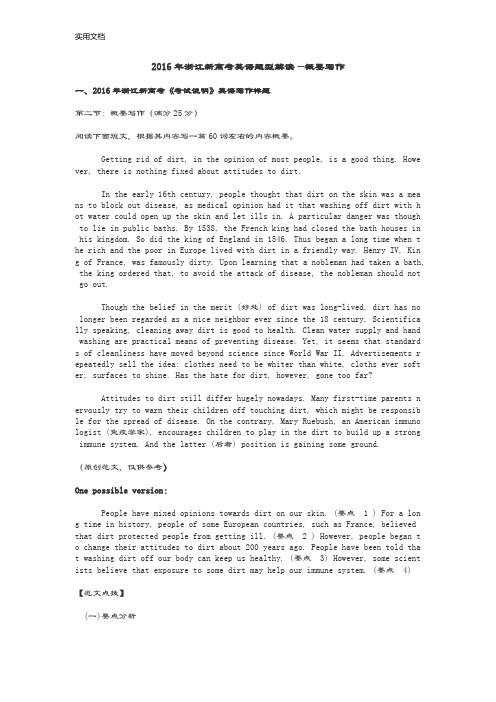
2016年浙江新高考英语题型解读—概要写作一、2016年浙江新高考《考试说明》英语写作样题第二节:概要写作(满分25分)阅读下面短文,根据其内容写一篇60词左右的内容概要。
Getting rid of dirt, in the opinion of most people, is a good thing. Howe ver, there is nothing fixed about attitudes to dirt.In the early 16th century, people thought that dirt on the skin was a mea ns to block out disease, as medical opinion had it that washing off dirt with h ot water could open up the skin and let ills in. A particular danger was though to lie in public baths. By 1538, the French king had closed the bath houses in his kingdom. So did the king of England in 1546. Thus began a long time when t he rich and the poor in Europe lived with dirt in a friendly way. Henry IV, Kin g of France, was famously dirty. Upon learning that a nobleman had taken a bath, the king ordered that, to avoid the attack of disease, the nobleman should not go out.Though the belief in the merit (好处) of dirt was long-lived, dirt has no longer been regarded as a nice neighbor ever since the 18 century. Scientifica lly speaking, cleaning away dirt is good to health. Clean water supply and hand washing are practical means of preventing disease. Yet, it seems that standard s of cleanliness have moved beyond science since World War II. Advertisements r epeatedly sell the idea: clothes need to be whiter than white, cloths ever soft er, surfaces to shine. Has the hate for dirt, however, gone too far?Attitudes to dirt still differ hugely nowadays. Many first-time parents n ervously try to warn their children off touching dirt, which might be responsib le for the spread of disease. On the contrary, Mary Ruebush, an American immuno logist (免疫学家), encourages children to play in the dirt to build up a strong immune system. And the latter (后者) position is gaining some ground.(原创范文,仅供参考)One possible version:People have mixed opinions towards dirt on our skin. (要点 1 ) For a lon g time in history, people of some European countries, such as France, believed that dirt protected people from getting ill. (要点 2 ) However, people began t o change their attitudes to dirt about 200 years ago. People have been told tha t washing dirt off our body can keep us healthy. (要点3) However, some scient ists believe that exposure to some dirt may help our immune system. (要点4)【范文点拨】(一)要点分析1. 文章第一段就是本篇文章的主题句,亮明了总的观点:However, there is n othing fixed about attitudes to dirt. 换句话说:Different people have differen t attitudes towards dirt. 再结合下文谈到的主题可知Different people have diffe rent attitudes towards dirt on the skin. 范文中的要点1“People have mixed opi nions towards dirt on our skin. ”概括非常精炼。
浙江新高考之概要写作summarywriting省公开课金奖全国赛课一等奖微课获奖PPT课件
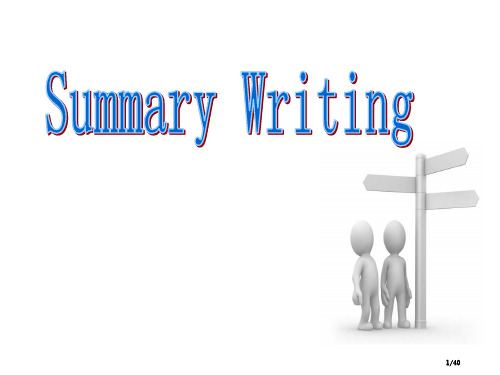
there is really a sixth sense
Only if you ask many different questions will you acquire all the information.
20/40
• … there is nothing fixed about attitudes to dirt.
have, exist, S+V+P
changing
opinions, viewpoints
✓People have changing opinions toward dirt over time.
10/40
2.把短语变为单词 Cleaning away day dirt benefits health.
3.使用广义词(general words)代替详细词 (specific words)
She brought home several Chinese and English novels, a few copies of Time and Newsweek, and some textbooks.
描写某事物性质功用。即“对
√ 说明文
象+性质功用+利好”; 针对某个问题提出处理方法或
exposition 方法。即“问题+处理方法”;
介绍某现象及其原因和结果。
√ 议论文
即“现象+原因+结果”
论点+论据(+结论)
argumentation
7/40
浙江省英语高考概要写作首考试题分析及反思
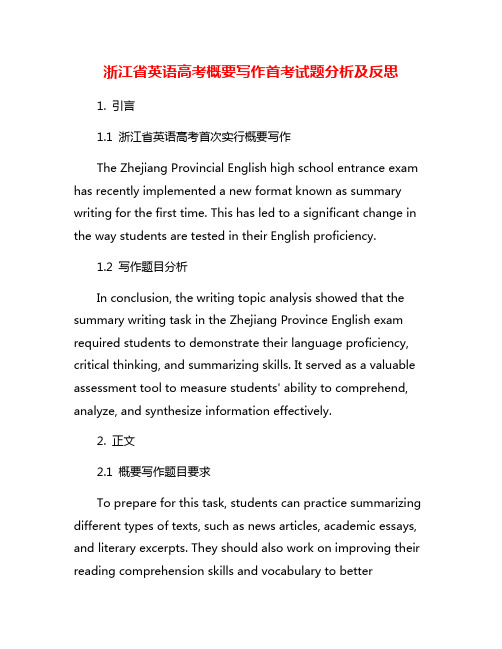
浙江省英语高考概要写作首考试题分析及反思1. 引言1.1 浙江省英语高考首次实行概要写作The Zhejiang Provincial English high school entrance exam has recently implemented a new format known as summary writing for the first time. This has led to a significant change in the way students are tested in their English proficiency.1.2 写作题目分析In conclusion, the writing topic analysis showed that the summary writing task in the Zhejiang Province English exam required students to demonstrate their language proficiency, critical thinking, and summarizing skills. It served as a valuable assessment tool to measure students' ability to comprehend, analyze, and synthesize information effectively.2. 正文2.1 概要写作题目要求To prepare for this task, students can practice summarizing different types of texts, such as news articles, academic essays, and literary excerpts. They should also work on improving their reading comprehension skills and vocabulary to betterunderstand and summarize complex passages. By practicing regularly and seeking feedback from teachers or peers, students can enhance their summarization abilities and perform well on the summary writing task in the Zhejiang English high school entrance examination.2.2 考生备考策略考生应该熟悉和理解概要写作的题目要求。
浙江新高考作文概要写作

What is a summary?
A summary is a short statement that gives only the main points of sth, not the details.
It is a brief, complete and objective restatement of the main idea and key points of a longer composition.
Similar cases of fraudulent (欺骗的) pricing at scenic spots have also been reported elsewhere in China. In October 2015, for instance, a tourist was overcharged for a course of shrimp (虾) in the coastal city of Qingdao, east China's Shandong Province, when the restaurant claimed the quoted price of 38 yuan was not for the dish, but for each shrimp! Authorities say that these illegal
Argumentation Exposition Narration
Recently, a wild fish restaurant was ordered to shut down in Harbin, northeast China's Heilongjiang Province. As a result, the owner of the restaurant faced a fine of 500,000 yuan.
- 1、下载文档前请自行甄别文档内容的完整性,平台不提供额外的编辑、内容补充、找答案等附加服务。
- 2、"仅部分预览"的文档,不可在线预览部分如存在完整性等问题,可反馈申请退款(可完整预览的文档不适用该条件!)。
- 3、如文档侵犯您的权益,请联系客服反馈,我们会尽快为您处理(人工客服工作时间:9:00-18:30)。
• Topic sentence?
Paragraph 2
• "The 'if it bleeds' rule works for mass media," says Jonah Berger, a scholar at the University of Pennsylvania. "They want your eyeballs and don't care how you're feeling. But when you share a story with your friends, you care a lot more how they react. You don't want them to think of you as a Debbie Downer." ) you don't want to
Summary Writing
Lead-in
Classic rules for ___________: 1. Bad news sells. 2. If it bleeds, it leads. 3. No news is good news, and good news is no news.
Activity 1&2
• What's the topic? • Underline the topic sentence of each paragraph.
Paragraph 1
• Bad news sells. If it bleeds, it leads. No news is good news, and good news is no news. Those are the classic rules for the evening broadcasts and the morning papers. But now that information is being spread and monitored (监控) in different ways, researchers are discovering new rules. By tracking people's e-mails and online posts, scientists have found that good news can spread faster and farther than disasters and sob stories. • Topic? Topic sentence? • Is the first sentence the topic sentence?
Paragraph 1
• Bad news sells. If it bleeds, it leads. No news is good news, and good news is no news. Those are the classic rules for the evening broadcasts and the morning papers. But now that information is being spread and monitored (监控) in different ways, researchers are discovering new rules. By tracking people's e-mails and online posts, scientists have found that good news can spread faster and farther than disasters and sob stories. • Topic? Topic sentence? • Is the first sentence the topic sentence?
• The new finding is that______spread faster and farther in______. • (While mass media usually tend to share _______news.) • Predict:What's going to be talked about in the following text?
• Topic sentence is .... • Unlike mass media, you tend to share _______( be a/an_____earchers analyzing word-of-mouth communication—e-mails, Web posts and reviews, face-to-face conversations—found that it tended to be more positive than negative(消极的), but that didn't necessarily mean people preferred positive news. Was positive news shared more often simply because people experienced more good things than bad things? To test for that possibility, Dr. Berger looked at how people spread a particular set of news stories: thousands of articles on The New York Times' website. He and a Penn colleague analyzed the "most e-mailed" list for six months. One of his first findings was that articles in the science section were much more likely to make the list than non-science articles. He found that science amazed Times' readers and made them want to share this positive feeling with others.
Pagagraph3
• Topic sentence is ....?
•
Researchers analyzing word-of-mouth communication—e-mails, Web posts and reviews, face-to-face conversations—found that it tended to be more positive than negative(消极的), but that didn't necessarily mean people preferred positive news. Was positive news shared more often simply because people experienced more good things than bad things? To test for that possibility, Dr. Berger looked at how people spread a particular set of news stories: thousands of articles on The New York Times' website. He and a Penn colleague analyzed the "most e-mailed" list for six months. One of his first findings was that articles in the science section were much more likely to make the list than non-science articles. He found that science amazed Times' readers and made them want to share this positive feeling with others.
Pagagraph3
• Topic sentence is ....?
•
Researchers analyzing word-of-mouth communication—e-mails, Web posts and reviews, face-to-face conversations—found that it tended to be more positive than negative(消极的), but that didn't necessarily mean people preferred positive news. Was positive news shared more often simply because people experienced more good things than bad things? To test for that possibility, Dr. Berger looked at how people spread a particular set of news stories: thousands of articles on The New York Times' website. He and a Penn colleague analyzed the "most e-mailed" list for six months. One of his first findings was that articles in the science section were much more likely to make the list than non-science articles. He found that science amazed Times' readers and made them want to share this positive feeling with others.
